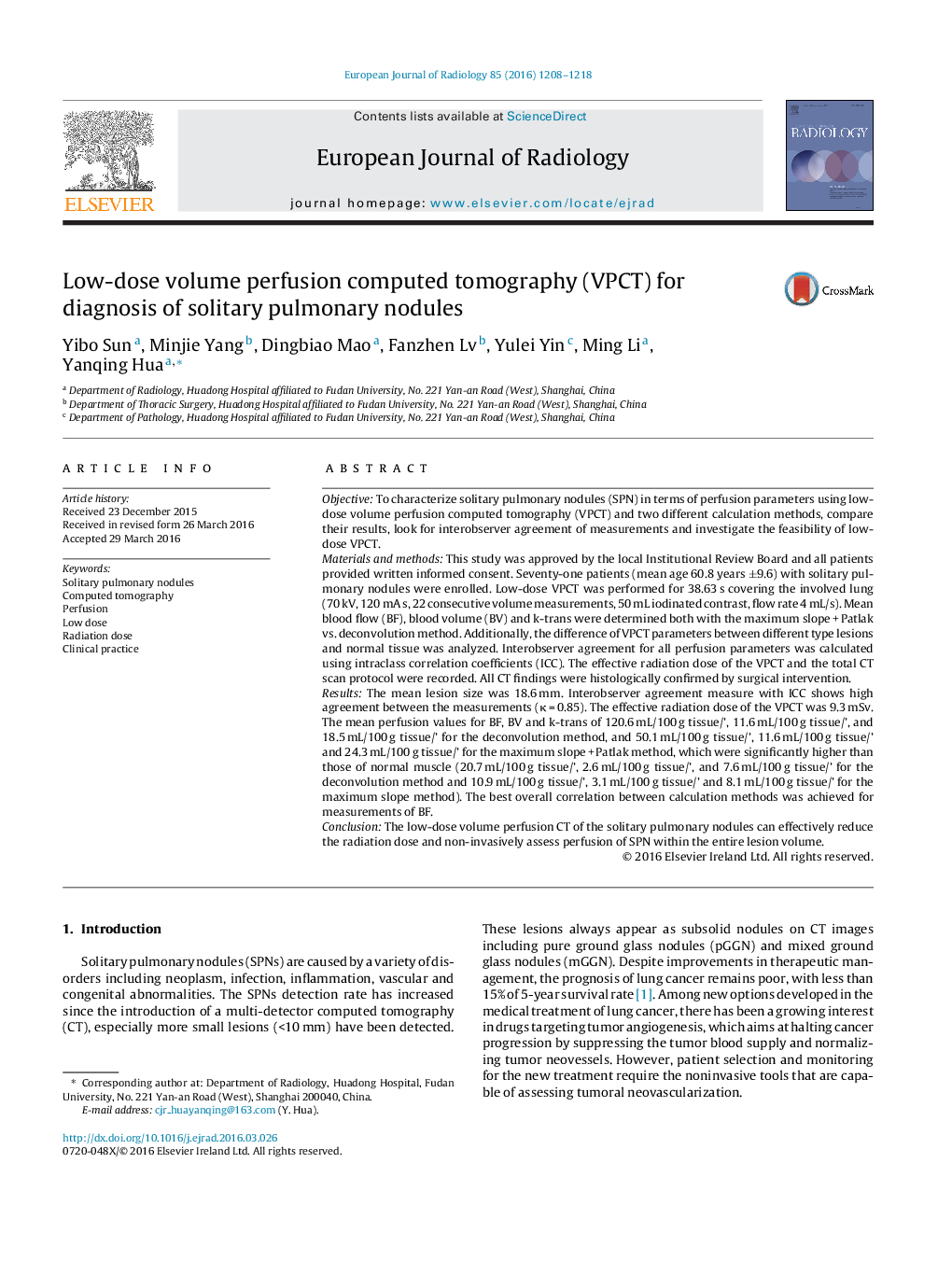| کد مقاله | کد نشریه | سال انتشار | مقاله انگلیسی | نسخه تمام متن |
|---|---|---|---|---|
| 4224843 | 1609741 | 2016 | 11 صفحه PDF | دانلود رایگان |

• The radiation dose of volume perfusion computed tomography (VPCT) can be successfully reduced by means of reducing tube voltage to 70 kV and that perfusion-based entire SPN characterization is feasible.
• The two calculation methods (maximum slop + Patlak and deconvolution) deliver different absolute values for parameters, such as BF, BV and k-trans, which correlate well for BF and BV.
• The perfusion parameters of 70 kV—VPCT can be used to differ the pulmonary lesion from normal tissue.
ObjectiveTo characterize solitary pulmonary nodules (SPN) in terms of perfusion parameters using low-dose volume perfusion computed tomography (VPCT) and two different calculation methods, compare their results, look for interobserver agreement of measurements and investigate the feasibility of low-dose VPCT.Materials and methodsThis study was approved by the local Institutional Review Board and all patients provided written informed consent. Seventy-one patients (mean age 60.8 years ±9.6) with solitary pulmonary nodules were enrolled. Low-dose VPCT was performed for 38.63 s covering the involved lung (70 kV, 120 mA s, 22 consecutive volume measurements, 50 mL iodinated contrast, flow rate 4 mL/s). Mean blood flow (BF), blood volume (BV) and k-trans were determined both with the maximum slope + Patlak vs. deconvolution method. Additionally, the difference of VPCT parameters between different type lesions and normal tissue was analyzed. Interobserver agreement for all perfusion parameters was calculated using intraclass correlation coefficients (ICC). The effective radiation dose of the VPCT and the total CT scan protocol were recorded. All CT findings were histologically confirmed by surgical intervention.ResultsThe mean lesion size was 18.6 mm. Interobserver agreement measure with ICC shows high agreement between the measurements (κ = 0.85). The effective radiation dose of the VPCT was 9.3 mSv. The mean perfusion values for BF, BV and k-trans of 120.6 mL/100 g tissue/’, 11.6 mL/100 g tissue/’, and 18.5 mL/100 g tissue/’ for the deconvolution method, and 50.1 mL/100 g tissue/’, 11.6 mL/100 g tissue/’ and 24.3 mL/100 g tissue/’ for the maximum slope + Patlak method, which were significantly higher than those of normal muscle (20.7 mL/100 g tissue/’, 2.6 mL/100 g tissue/’, and 7.6 mL/100 g tissue/’ for the deconvolution method and 10.9 mL/100 g tissue/’, 3.1 mL/100 g tissue/’ and 8.1 mL/100 g tissue/’ for the maximum slope method). The best overall correlation between calculation methods was achieved for measurements of BF.ConclusionThe low-dose volume perfusion CT of the solitary pulmonary nodules can effectively reduce the radiation dose and non-invasively assess perfusion of SPN within the entire lesion volume.
Journal: European Journal of Radiology - Volume 85, Issue 6, June 2016, Pages 1208–1218